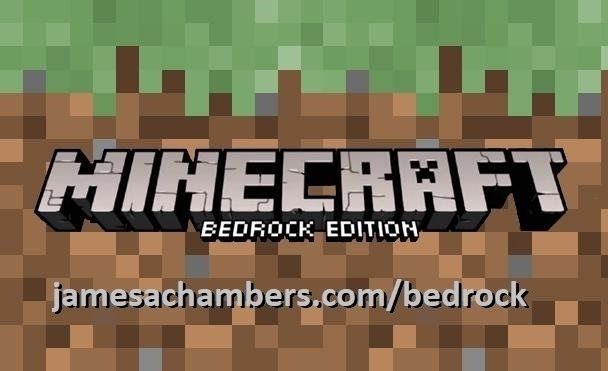
Minecraft Bedrock Edition is the version of Minecraft that powers the iPhone / Android versions (formerly Minecraft Pocket Edition), the Xbox / PlayStation / Nintendo Switch editions and the free Windows 10 Minecraft edition.
Mojang has released a dedicated server which is considered to be in alpha testing. I have found it to be very stable and able to run on a wide variety of hardware.
This script and guide are written to help you get a robust Minecraft Bedrock dedicated server up and running in only a few minutes!
This is the standalone version. The easiest and most problem-free way to run this is using Docker (installed as simply as sudo apt install docker.io): Legendary Minecraft Bedrock Container
I’ve also released a way for Java and Bedrock players to play on the same server using Geyser: Minecraft Java + Bedrock Server Together – Geyser + Floodgate
It’s now possible to convert your worlds between Bedrock and Java versions. Check out my guide on Chunker here for more information.
Features
- Sets up the official Minecraft Bedrock Server (currently in alpha testing)
- Fully operational Minecraft Bedrock edition server in a couple of minutes
- Ubuntu / Debian distributions supported
- Sets up Minecraft as a system service with option to autostart at boot
- Automatic backups when server restarts
- Supports multiple instances — you can run multiple Bedrock servers on the same system
- Updates automatically to the latest or user-defined version when server is started
- Easy control of server with start.sh, stop.sh and restart.sh scripts
- Adds logging with timestamps to “logs” directory
- Optional scheduled daily restart of server using cron
Requirements
- A computer with a 64 bit processor (if you are trying to use ARM read my article on the limitations). 32 bit binaries of the official server are not available so it needs to be 64 bit!
- 1 GB of RAM or higher
- The only officially supported platform by Microsoft is Ubuntu 22.04 / 20.04 (current LTS, recommended)
- Other Linux flavors supported by this script as well as long as they use systemd (for the service). The script assumes apt is installed but there are minimal dependencies so you could install these on another distro (that doesn’t have apt present) and use the script normally.
Recommended Gear
Game Editions
Minecraft: Bedrock Edition is the “Windows 10” version of Minecraft as well as the version of Minecraft on the Xbox / Playstation / Switch. The versions of Minecraft for Android and iOS are also the Bedrock edition.
All of these versions support cross-platform play with each other (but not with the Java edition).

This is the PC Minecraft for Windows 10 (Bedrock) edition of Minecraft. It is able to play cross-platform with other players on Android / iOS / Playstation / Xbox / Switch. Available as a code that is instantly activated to give you permanent access to the game!
Links: Amazon.com*, Amazon.co.jp*, Amazon.co.uk*, Amazon.de*, Amazon.es*, Amazon.fr*, Amazon.it*

The Sony PlayStation version of Minecraft: Bedrock edition.
Links: Amazon.com*, Amazon.ca*, Amazon.com.au*, Amazon.co.jp*, Amazon.co.uk*, Amazon.de*, Amazon.es*, Amazon.fr*, Amazon.it*, Amazon.nl*, Amazon.se*, Amazon.sg*

This is the Nintendo Switch version of Minecraft: Bedrock edition.
Links: Amazon.com*, Amazon.ca*, Amazon.com.au*, Amazon.co.jp*, Amazon.co.uk*, Amazon.de*, Amazon.es*, Amazon.fr*, Amazon.it*, Amazon.nl*, Amazon.pl*, Amazon.se*, Amazon.sg*

This is the Microsoft Xbox version of Minecraft: Bedrock edition.
Links: Amazon.com*, Amazon.ca*, Amazon.com.au*, Amazon.co.uk*, Amazon.de*, Amazon.es*, Amazon.fr*, Amazon.it*, Amazon.nl*, Amazon.sg*
Recommended Storage (Solid State Drive)
I strongly recommend a Solid State drive (SSD) for your server. This is because Minecraft is constantly reading/storing chunks to the disk which makes I/O performance very important.
These are much cheaper than they used to be. Here’s a decent 120 GB one (higher capacity options are available) at a very low price:
The Kingston A400 is reliable, widely available around the world, has low power requirements and performs very well. It’s also very affordable. This drive has been benchmarked over 1000 times at Pi Benchmarks and is the #1 most popular SSD among the community!
Links: AliExpress*, Amazon.com*, Amazon.ca*, Amazon.com.au*, Amazon.co.jp*, Amazon.co.uk*, Amazon.de*, Amazon.es*, Amazon.fr*, Amazon.it*, Amazon.nl*, Amazon.pl*, Amazon.se*, Amazon.sg*
If you have a M.2 NVME slot in your motherboard you can go with a high end drive. This will give your server maximum performance even if a large number of players are running around on the server changing blocks and triggering disk writes.
This is the one I have in my machine. These range from 250 GB to 2 TB depending on how big your server might grow:
The Samsung 980 Pro (NVMe) is a professional grade SSD and one of the fastest in the world. The Samsung NVMe drives have been at the top of this category for a long time and are well trusted for both their performance and reliability / long life.
Links: AliExpress*, Amazon.com*, Amazon.ca*, Amazon.com.au*, Amazon.co.jp*, Amazon.co.uk*, Amazon.de*, Amazon.es*, Amazon.fr*, Amazon.it*, Amazon.nl*, Amazon.pl*, Amazon.se*, Amazon.sg*
Computer / CPU / Memory
Almost any PC made in the last few years will be a x86_64 bit computer. If you have an older computer around that isn’t being used then it will most likely have the right CPU and amount of memory (as well as fast storage) to run a basic server.
Throwing a SSD in one of these older computers will provide an excellent server experience for small and larger player counts.
The speed of your storage will make the largest difference. Older HDDs are going to have significantly slower performance than any modern SSD even with all other hardware equal. This is because the Minecraft server is constantly reading/writing chunks of your world as well as updates to it to the disk so this tends to be the bottleneck.
Operating System
I highly recommend using Ubuntu Server to run the Minecraft dedicated server. It is available here.
At the time of writing the current version is Ubuntu Server 20.04. This is a secure and robust operating system and will leave plenty of resources available for the server to run.
The script should run on any Debian based flavor of Linux but since the Minecraft Bedrock server is compiled natively for Ubuntu I recommend sticking with it. If you have a GUI flavor of Ubuntu and a decent PC (>= 2 GB of RAM) the server will work just fine on it.
Note: People have reported in the comments that Ubuntu 16.x is no longer working with the latest official Mojang binaries. Ubuntu 18.04 is the minimum requirement for the latest versions, and 20.04 is recommended!
Installation
Log into your Linux server either using SSH or a mouse and keyboard and paste/type the following command:
curl https://raw.githubusercontent.com/TheRemote/MinecraftBedrockServer/master/SetupMinecraft.sh | bashThe script will setup the Minecraft sever and ask you some questions on how to configure it. I’ll explain here what they mean.
The first question will be the installation path. This is the root installation path for ALL servers you will have. If you add additional servers later you should select the exact same installation path. It should always be left as the default (~).
The only exception is if you have something like a completely dedicated disk for the Minecraft server. In that case you should always use the same root path of /mnt/yourdrive or wherever the path is for every new/additional server you install.
“Start Minecraft server at startup automatically (y/n)?” – This will set the Minecraft service to start automatically when your server boots. This is a great option to set up a Minecraft server that is always available.
“Automatically restart and backup server at 4am daily (y/n)?” – This will add a cron job to the server that reboots the server every day at 4am. This is great because every time the server restarts it backs up the server and updates to the latest version. See the “Scheduled Daily Reboots” section below for information on how to customize the time or remove the reboot.
That is it for the setup script. The server will finish configuring and start!
First Run
The server will start up and start displaying output to the console.
[2019-03-30 20:25:12 INFO] Starting Server
[2019-03-30 20:25:12 INFO] Version 1.10.0.7
[2019-03-30 20:25:12 INFO] Level Name: Bedrock level
[2019-03-30 20:25:12 INFO] Game mode: 0 Survival
[2019-03-30 20:25:12 INFO] Difficulty: 1 EASY
[2019-03-30 20:25:20 INFO] IPv4 supported, port: 19132
[2019-03-30 20:25:20 INFO] IPv6 supported, port: 19133
[2019-03-30 20:25:23 INFO] Server started.
Once you see the “Server started” line you will be able to connect from the client.
To add the server to the client open Minecraft and click “Play”. Then at the top of the screen select the “Servers” tab and click “Add Server”.
This will ask you for a Server Name and Server IP Address. For the name you can put anything and for the server IP address put the address of your Linux server. Leave the port as the default 19132. For more information on how to let people from outside your network on go to the “Port Forwarding” section below.
Now choose the server you just added in the list and connect!
Start, Stop and Restart Server
The server can be started, stopped and restarted two different ways. You can use the provided scripts in the Minecraft folder or you can use systemctl. Here are the commands:
cd ~/minecraftbe ./start.sh ./stop.sh ./restart.sh -OR- sudo systemctl start minecraftbe sudo systemctl stop minecraftbe sudo systemctl restart minecraftbe
Automatic Backups
The server backs up each time it starts. This helps you recover easily if something goes wrong. This system works best if you configured the server to restart daily since it means you will have a backup every day.
To access these backups type:
cd ~/minecraftbe/backups
ls
When a backup is made the filename will be the date and time the backup was taken. If you need to restore a backup it’s very easy. Substitute the timestamp in my example to the backup you want to roll back to. Type:
cd ~/minecraftbe ./stop.sh rm -rf worlds tar -xf backups/2019.02.15.22.06.30.tar.gz ./start.sh
Your world has now been restored! It’s a good idea to download these backups off the server periodically just in case the server’s storage fails.
Installing Resource Packs / RTX Support
For instructions on how to install resource packs (including optional RTX support) view my step by step Minecraft Bedrock Dedicated Server Resource Packs guide here.
Scheduled Daily Reboots
The daily reboots are scheduled using cron. It’s very easy to customize the time your server restarts.
To change the time that the server restarts type: crontab -e
This will open a window that will ask you to select a text editor (I find nano to be the easiest) and will show the cronjobs scheduled on the server. The Minecraft one will look like the following:
0 4 * * * /home/ubuntu/minecraftbe/restart.sh
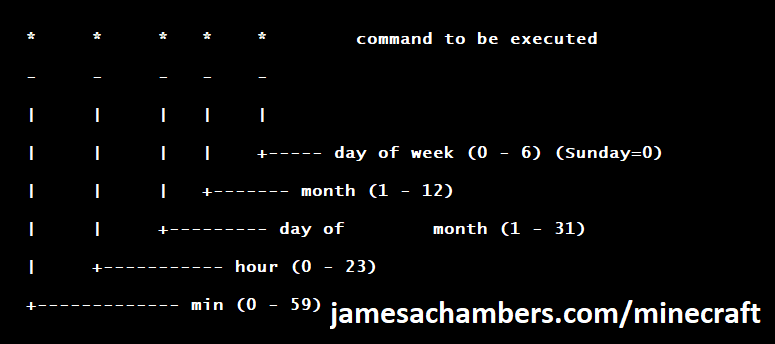
There are 5 fields here. The default restart time is set to reboot at 0 minutes of the 4th hour of the day (4 AM). The other 3 fields are left as * to represent every day of every month. Make any desired changes here and press Ctrl+X to exit nano and update the cronjob.
To remove the daily reboot simply delete the line and save.
Reconfigure / Update Scripts
The scripts can always be reconfigured and updated by downloading the latest SetupMinecraft.sh and running the installer again. It will update all of the scripts in the Minecraft directory and reinstall the startup service for you.
Running SetupMinecraft.sh again will also give you a chance to reconfigure options such as the memory dedicated to the server, daily reboots, starting the server on boot, etc.
This will not overwrite your world or any other data so it is safe to run!
Port Forwarding
If everyone on your server is on the same LAN or WiFi network as you then you don’t need to do this. If you want people to connect from outside your local network then you need to set up port forwarding on your router.
The process for this is different for every router so the best thing to do is just look at your router and find the model # and put that in google with port forwarding for easy instructions on how to do it for your specific router.
You want to forward port 19132. The type of connection is both TCP and UDP. On some routers you need to do both a TCP entry and then a second entry as UDP.
Once you do this people will be able to connect to your Minecraft server through your public IP address. This is different than your local IP which is usually a 192.x.x.x or 10.x.x.x. If you don’t know what that is just go to google and type “what’s my ip” and Google will kindly tell you!
Version Override
You can revert to a previous version with the revert.sh script included in your directory like this:
james@jamesgigabyte-linux:~/minecraftbe/james$ ./revert.sh Set previous version in version_pin.txt: bedrock-server-1.19.10.20.zip
If you have a specific version you would like to run you can also create version_pin.txt yourself like this:
echo "bedrock-server-1.18.33.02.zip" > version_pin.txt
The version hold can be removed by deleting version_pin.txt. This will allow it to update to the latest version again!
Wired vs. Wireless
Going with an ethernet (wired) connection is going to be faster and more reliable. There’s so much wireless traffic and other interference in the air that running your server on WiFi is not recommended.
Even if it is working great 99% of the time it can ruin your experience very quickly if the WiFi drops for a couple of seconds and you get blown up by a creeper!
All that being said, the server works fine on wireless. The script will work fine as is with a wireless connection.
Benchmarking / Testing Storage
If you’re getting poor performance you may want to run my storage benchmark with:
sudo curl https://raw.githubusercontent.com/TheRemote/PiBenchmarks/master/Storage.sh | sudo bash
PC results won’t show up on the site yet (it’s meant for Raspberry Pi) but it will run on Linux just fine and give you a score. If you search for the model of your drive on Pi Benchmarks you can compare your score with others and make sure the drive is performing correctly!
Troubleshooting Note – Oracle Virtual Machines
A very common problem people have with the Oracle Virtual Machine tutorials out there that typically show you how to use a free VM is that the VM is much more difficult to configure than just about any other product / offering out there.
It is because there are several steps you need to take to open the ports on the Oracle VM. You need to both:
- Set the ingress ports (TCP/UDP) in the Virtual Cloud Network (VCN) security list
- *and* set the ingress ports in a Network Security Group assigned to your instance
Both of these settings are typically required before you will be able to connect to your VM instance. This is purely configuration related and has nothing to do with the script or the Minecraft server itself.
I do not recommend this platform due to the configuration difficulty but the people who have gone through the pain of configuring an Oracle VM have had good experiences with it after that point. Just keep in mind it’s going to be a rough ride through the configuration for most people.
Troubleshooting Note – Hyper-V
There is a weird bug in Hyper-V that breaks UDP connections on the Minecraft server. The fix for this is that you have to use a Generation 1 VM with the Legacy LAN network driver.
Conclusion
The Minecraft Bedrock Edition dedicated server runs much better than previous third party servers in the past that were missing critical features. The performance is very good even on low end hardware. It has never been easier to set up a Minecraft Bedrock server.
If you have any feedback or suggestions let me know in the comment section. A lot of the changes and developments in this script and guide are directly from readers.
Have fun!
Other Resources
For a guide on how to set up resource packs check out my Minecraft Bedrock Resource Pack guide
If you’re trying to run this on the Raspberry Pi check out the Raspberry Pi specific guide here



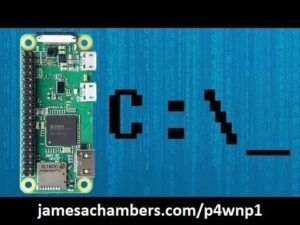
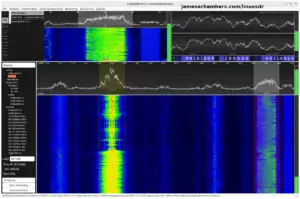
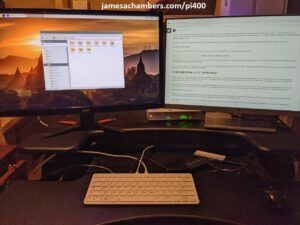
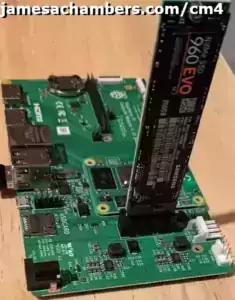

ok I am new to “ubuntu-server” and I was wanting to know after installing this bedrock server how do you OP someone and put in commands in the terminal?
Hey Brandon,
Welcome! I think I can definitely help. The easiest way is to pull up the server console by typing:
screen -rThis will bring up the server console in your active window that you type that command in. That’s the window that you can type op “your player” or op yourplayer in the console in.
You can minimize the console again by pressing Ctrl+A followed by Ctrl+D. Hopefully that helps!
Hello, firstly, I wanted to say THANK YOU for this fantastic resource! I went from knowing NOTHING about Minecraft servers to getting everything up and running on a Digital Ocean droplet with Ubuntu 22.04 LTS. Much thanks to the information here!
My question is in regard to the “Wild Update” with the new Ancient City, Deep Dark biome, the Warden, etc. I have been scouring the internet for information on how to enable this on a Bedrock Server. What I have tried is to enable the Wild Update from an iOS device with the pencil/edit screen, then to upload the copy of this world to the bedrock server. The world runs fine. However, when I check in-game settings on my iOS device while running from the server, the setting does not show the “Wild Update” as enabled. Is there a procedure to enable the “Wild Update” on a bedrock server?
Hey Christian,
Is the version of the Minecraft client on iOS 1.19? If so it should absolutely work. All of those features are released now as the official 1.19.1 release. It should tell you the version of the server that is running. If it lets you connect to your world then it should indeed be on 1.19.
Basically if your server and client are showing 1.19 then you have the Wild Update content enabled. You can safely ignore the world not having the checkbox enabled. The Warden and all of those features will be server-side in multiplayer so there is definitely no checkbox required to enable these features (it happens on the server). You just need to be running the right version (and it won’t let you connect if it’s a version mismatch typically at least across major versions like that).
In other words I believe this is a “UI glitch”. That checkbox won’t change anything related to the dedicated server or multiplayer basically as these features are turned on / built into the dedicated server and while there are new options related to the new features to control them they generally can’t be turned off for the most part. This checkbox will not have an impact on your dedicated server and is related to seed/world generation in offline play. If the version you are running says 1.19 on iOS then you are good to go as far as the dedicated server.
There have been similar checkboxes to this on iOS and other platforms in the past for other updates and they won’t impact the dedicated server (the dedicated server has it’s own options that are controlled by server.properties and /gamerules). Keep in mind that the server/seed generation is *all* server side on a dedicated server so this box would definitely have no impact for this feature. It’s probably used in shared multiplayer (if that still works, it definitely used to but I’ve been using the dedicated server for many years now exclusively) but for the dedicated server you’re covered without having this checked.
Hopefully that helps and thank you very much for the kind words about the script, let me know if you have further questions or if I can clarify anything!
James, great instinct on that being a “UI glitch”! You were absolutely correct! I have verified this by visiting an Ancient City on the world that I mentioned as not having the “Wild Update” enabled in the in-game client UI (client is running 1.19). By the way, http://www.chunkbase.com/apps/seed-map is a great resource that I have used a lot over the years, and it is updated with the locations for the 1.19 features like the Ancient Cities. Thank you James for all the great work and assistance here. It is much appreciated!!!
Hey Christian,
Thank you for confirming my theory! This was just based on past versions which had similar checkboxes (which also didn’t impact the dedicated server) such as the World of Water update I remember having one and a few others. The rule of thumb seems to be that these do matter in peer-to-peer where one of the players is hosting the server on another client (non-dedicated) but do not matter on the dedicated server for sure.
That is a very cool seed map! The seeds are extremely fun and you can also use these on a dedicated server in the server.properties file. The earlier you put it in there the better (it’s best on a fresh server) so that it generates all chunks using that specific seed. I’ve done this before and I’m a huge fan of the seeds with “repeating” features along borders (this happens when the random numbers all line up and happen to “cancel out”). I was just watching a YouTube video of some really crazy repeating mineshafts that are basically neverending all the way until the world border!
Thanks for the kind words and assistance, you’re always welcome, take care and have fun!
I have a bedrock server running on a linux machine.
But i have no option in minecraft to enter ip or join the server.
Hey Dennis,
I’m not sure what to make of this one. That would be a client side issue. The instructions on how to connect are here!
Do you not see the same menu options to add an IP address? You should see this whether the server is working or not as this is all client-side if I’m understanding correctly!
Hi James, thanks for this amazing script, I downloaded the latest version from minecraft.net, but they only put 1.19.1 there, is there a way to get 1.19.0
Hey Aiden,
1.19.1 is the current release now. The beta release was actually 1.19.10 (this came up here in the comments a few days ago).
Basically the one on the site is the latest version now that matches the one on the store. I checked to see if a 1.19.0 version existed on Microsoft’s servers and it does not. This is still the first release they went live with (after the beta prerelease) and they haven’t done any minor revisions yet.
Basically you should be good to go with the latest version on their site. That should be the one the client is using at the moment. Hopefully that helps!
I’ve asked the minecraft technical support and they said the latest version is 1.19.1 too, but my client on my ios device is somehow 1.19.0, I don’t know if others have the same problem
Hey Aiden,
Is it giving you an error when you try to connect with it? I haven’t heard of anyone else having this problem yet so far!
Hi James, I don’t know cuz it shows outdated client when I try to connect it, but i don’t see any update option in my app store.
Hey Aiden,
Can you try running update.sh from your server folder? You can also do a:
curl https://raw.githubusercontent.com/TheRemote/MinecraftBedrockServer/master/SetupMinecraft.sh | bashAlso make sure you have removed version_pin.txt from the last version from your server folder. That should take care of it here!
Hi James, i tried the method but my client is still outdated, I checked the version history in app store again but it shows the latest version i can get is 1.19.0, is that my phone’s problem or mojang haven’t released 1.19.1 on app store ?
Hey Aiden,
Is it working on PC? There’s no such thing as 1.19.0 and the first release was 1.19.1. I’d run SetupMinecraft.sh again as there have been updates that may fix this but we’re still on the initial release of 1.19.1.01. They basically haven’t released anything except the initial release so I would assume that it’s right on the phone.
There’s basically no other version it could be. The beta was never released for phones and that was something like 1.19.10. There’s only been one release of 1.19 and it’s 1.19.1.01 basically (and still is on the web site since 1.19 came out). If the phone says it’s running 1.19 then it’s the server that is wrong.
I suspect you may have the 1.19.10 beta version (old, not even a real release, Microsoft should have never put that on their site) if you have version_pin.txt in your folder or that you need to run SetupMinecraft.sh again. One of those should get it going for you!
Hi James,
since your script works so good i did not check the server often. Now my Usere compain that they can ‘t join anymore. What i found out (i was guessing the first time was a misstake) the allow or whitelist was completly empty.
is there a way in your script to check das allow list also and back it up or rewrite it id it get modified ?
Thanks
Eike
Hey Eike,
I can definitely add some protection for this! Does it actually not load if the file isn’t present? I have some ways to check for other default files already and I can definitely add this to them!
UPDATE: this was added today! Make sure your whitelist settings are correct in server.properties as you shouldn’t need to whitelist unless that’s how you want to have it set up.
Take care!
Hi James,
it loads the List. It was, since some Versions, complete empty. So it looks like if there is a version jump from one to another version, the list will be complete wipes out. nice that you add somesome to safe it.
last stupit question ? do i have to update your script ? 🙂
thanks
eike
Hey Eike,
No worries at all, it’s not a stupid question! So to update the scripts there is a script called “update.sh” in your Minecraft server folder you can run with ./update.sh.
You can also just run SetupMinecraft.sh again with:
curl https://raw.githubusercontent.com/TheRemote/MinecraftBedrockServer/master/SetupMinecraft.sh | bashThat should get it going for you!
Hey there james! Quick aside, are you aware jamesachambers.com redirects to a YouTube video? I would just like to know if this is on purpose or a possible hack.
Best, Ben
Hey BenTechCoder,
Welcome back! So I found that last night and I think maybe I did it on accident, but I had the same thought as you. The site is pretty heavily secured but I’m very aware that certainly doesn’t mean it’s impossible to hack. If it was an attack there hasn’t been any further signs of any trouble so I’m guessing I did this at some point when I was doing redirects.
I do redirect some malicious attacks to that video in the backend so it’s not completely coming out of left field otherwise I’d be certain I was hacked. I do not feel like I would have added one to literally the main page of the web site though but maybe it got selected in a batch somehow and I missed it (again, not sure how this could happen since I select the batches from URLs that are 404s and it doesn’t make sense that the main jamesachambers.com root page would ever be a 404).
That should be fixed now but you may have the redirect cached in your browser. Can you try opening a private tab in your browser or clearing your cache and then trying again to make sure it’s fixed? I’m guessing it’s just cached in there but I’d love to confirm if you can!
Hello!
I’m checking in to see if anyone else ran into this issue. Saw today was the big day, updated my clients to the official 1.19.5.0 release from the Microsoft store. I removed my versions_pin.txt file and ran the update, and see that I had installed 1.19.10.20 again. Confused I checked to see what was on the download store, and 1.19.1.01 is listed there. I was able to use the version_pin.txt to download and install the 1.19.1.01 bedrock release on my server, and tested that my clients can connect. World loaded and functional without any issues.
Wondering if somehow I still have the original lingering 1.19.10.20.zip file somewhere on my server that it keeps going to because that would technically be the newest release? Not overly concerned, if I have to use the pinned text document for awhile that’s fine, but if there is something easily I can check/do that will get the server back to being able to update on it’s own correctly, thought I would ask (before going down the rabbit hole myself looking). Just seems like a brain teaser at this point.
I’ve heard from different online sources that this release seems to have a lot going on, and causing difficulty for many. I think, overall, “we” have managed very well through this transition though.
Sincerely…
~Max
Hey Max,
Great question. That version is basically a beta prerelease. It’s out of sequence with the rest of the versions. It’s definitely not ahead of them if that makes sense. If it doesn’t make sense I definitely can sympathize as not a lot about this release has made a lot of sense!
The current release on Microsoft’s page after clicking “I Agree” is
https://minecraft.azureedge.net/bin-linux/bedrock-server-1.19.1.01.zipor 1.19.1.01.The reason the 1.19.10 makes no sense is because it was a prerelease version. That’s actually an “old” version. It doesn’t follow any of the other versioning because they gave it a special branch. Now as of today though the latest version is 1.19.1.01 (which makes sense again and follows their normal versioning). I really dislike how this whole release was done and it really has confused everyone / makes no sense.
Now to answer the question about whether you still have the file the answer is absolutely yes. It should just be in your “downloads” folder in your Minecraft server folder. These currently aren’t pruned (this will probably become a problem eventually) so you should have every version you’ve ever downloaded provided you’ve never cleaned it out before.
I think you can do what you’re trying to do but that you won’t want to. The Microsoft store version should match the 1.19.1 release that is live on Microsoft’s site now. If it doesn’t you may be enrolled in the beta and have to unenroll to go back to the normal version. You could also have all the players enroll in beta if there was something in that prerelease that isn’t in the full official 1.19 release yet (they have done it in the past like for the Minecraft RTX graphics features/release).
I’m not sure how bad the transition will be for this one yet but I can tell you from personal experience that most of them that I can remember since 1.12ish have had some kind of problem and some of them were a complete nightmare. My advice is to just make sure you have backups before running the newest version so you can roll back. If it turns out to be unstable you will be very glad you did this and in a lot of trouble if you didn’t.
As long as you have backups you’ll have options at least!
Hello James…
Thank you, once again, for taking the time to reply and put in the detail! It’s much appreciated! What you said in your reply did make sense, and for some reason gave me a few “duh” moments for things I did not think of.
For as many times as I’ve looked at the Minecraft folder on my server, I never saw the ‘downloads’ folder. My bad! Thank you for pointing that out, I have taken care of the weird beta version files and should not be a problem (but I know where to look now, thank you!) . The funny thing is I thought the script just downloaded whatever was linked off of the main download page (I was checking the download links already), but makes more sense now.
Yes sadly when I got into Minecraft, I bought it off of the Microsoft store at the time. So dealing with that thing is always fun. But was able to get it downloaded and upgraded finally, and even though they list the version as 1.19.5.0 (though in-game is listed as 1.19.0), that was easy.
Overall from your contributions to our setup, that was the easiest part!
Side note, speaking of backups (which I also copy a version over to our NAS on the daily to ensure we have a backup), it’s easy enough to just copy those ack and extract them? I ask more because I’m thinking of upgrading our Ubuntu 20.04 server and reloading it with 22.04, any thoughts on 22.04?
No rush on the reply, thank you again for the support!
Cheers,
~Max
Hey Max,
Great additional questions, I’m glad my reply helped! Don’t sweat it about the downloads folder. I had honestly forgotten myself that they were all stored in there as it had been years since I’d ever considered changing much to do with that part of the script(s).
For the backups you’re right that they’re pretty easy/simple to extract. They are just archive files and it’s totally fine to extract them over the top of a new server you’ve set up for example (just for the purpose of restoring the backup). They also don’t depend on the scripts at all so you can restore the backup to a vanilla server even if you wanted to. Thanks for your gracious reply, hopefully that helps and take care!